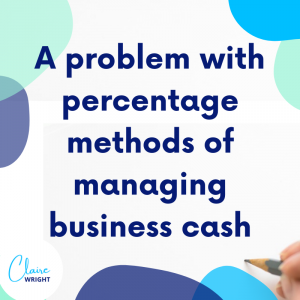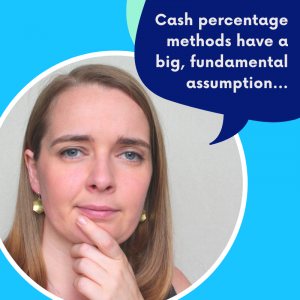Cash flow is king. A cardinal rule of small business finance. It’s also a cardinal rule of personal finance because there’ll be a problem if you don’t have the cash to pay your rent or mortgage or utilities. But there’s a problem with percentage methods of cash management that is often overlooked.
The truth is these money management methods are based on one big assumption…
That there is always enough to pay for the essentials
What are cash management methods?
Effectively I’m talking about when you set a percentage of income (or profit) to go to certain purposes. 10% to business expenses, 25% to taxes, 10% to superannuation, 5% to profit and 50% to salary.
So you make $2,000 in the month (or receive $2,000 in cash) and then you allocate that across the different budgets (whether you call them accounts, jars, envelopes, pots or buckets). From the example percentages that means the $2,000 is allocated as:
- 10% to biz expenses = $200
- 25% to taxes = $500
- 10% to superannuation = $200
- 5% to profit = $100
- 50% to salary = $1,000
But what if you need $1,450 to cover your monthly living expenses for the essentials like food and housing? You have to start dipping into the other pots and your percentage goes out of the window.
The method is based on the assumption that there is always enough coming in to cover those essentials at the allocated percentage. If you have a fixed salary, it might be fine, but for sole traders, that is not the case!
Everything isn’t Equal Priority
There are just some outgoings that need to be paid before others. You could argue food is more important than housing. But I’m sure we’d agree both are more important than new shoes. There’s a certain order in paying expenses. Superannuation for sole traders isn’t essential, but having heating, power and food is essential. They aren’t equal priorities.
There’s an order to your expenses and for sole traders, it’s often that personal expenses are more important than business expenses. Now there’s an argument about the ‘tools of the trade’ expenses you need to run your business and earn an income. Agree, but you always want to try to keep them as low as possible.
The methods often encourage saving a contingency fund for when the cash coming in isn’t enough. But that assumes at some point there is MORE than enough coming in. And this dip is only short-lived before returning to having enough coming in.
My Cash Management Method
I’ve been using one of the percentage allocation methods since April 2019. And it worked because I had enough coming in, and my spouse works full-time. For the longest time, I thought it was fine, but then recently I questioned the assumption that there would always be enough.
So I reinvented my percentage methods of cash management with priorities:
- Taxes calculated on how much came in that month (yes it is possible to estimate month by month)
- Personal essentials – housing, groceries, pet food, insurances etc.
- Superannuation – saving for my retirement is important to me.
- Household extras – gifts, giving, holidays and a bit of shopping
- Savings, business expenses & personal extras – these three are equal within priority five. 20% straight to savings. Business expenses include bookkeeping, membership & mindset support. Personal items include clothes, shoes, books and crafting.
- Fun & investing – if all of the above is cover there are no rules, except investing in my future and enjoying life are equally important
It’s Levels of Priority
They are ordered like levels, if level 1 is paid then money flows into level 2, when level 2 is covered the excess flows into level 3 and so on. It means my absolutely non-negotiable priorities are paid first and in full; tax and living. And I get to choose the priorities, say I add a non-negotiable business expense then it can slot in equal priority with personal non-negotiable.
It all lives in an automated spreadsheet and the biggest realisation was I can afford EVERYTHING I want [well maybe not the electric conversion for the campervan yet]. But those items, experiences and services in the personal extras and fun levels. Currently, there’s enough coming in if I want a cleaner, enough for a regular book budget and a stationery budget!
And I didn’t really know this before, it was just vague percentages. I have 10% for expenses, but what does that cover exactly? What about 5% profit should that be spending or saving? Money was accumulating in accounts with basically no purpose.
The Problem with Percentage Methods of Cash Management
These methods can work, and cash management is super important. But like with marketing and business strategy don’t expect something straight from the textbook to work for you. Critically analyse it and reflect it through what is important to you, how you want your business (and money) to work and your needs.
If you need help claiming your rightful role as the boss of your business and taking things like finances and financial systems and cash management seriously so you can grow your business then get in touch for a free chat about how we could work together.
Watch the Video
Pin for Later


